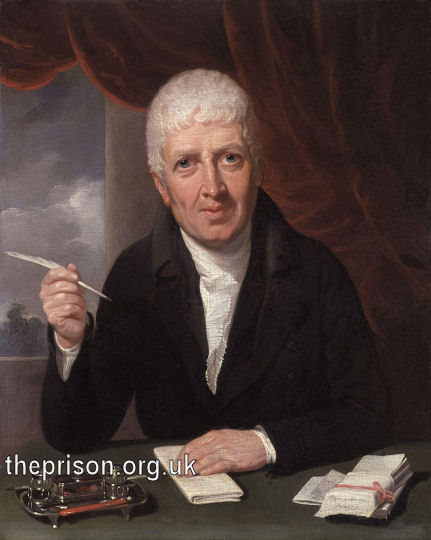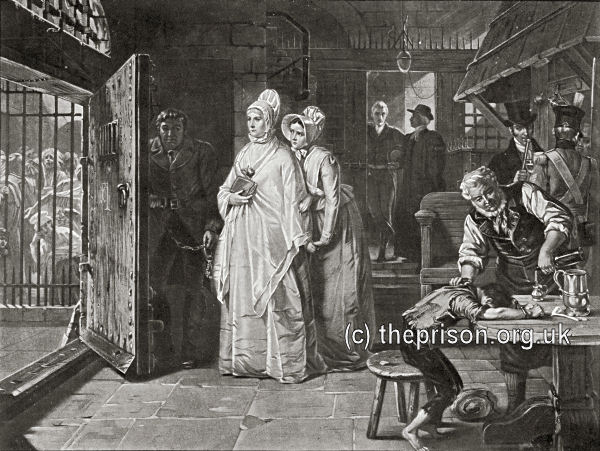Prison Reform
John Howard
The reform of prisons began in the 18th century, something with which the name of John Howard is particularly associated. After his appointment in 1773 as High Sheriff of Bedfordshire, and thus attending court proceedings, Howard was surprised to learn that acquitted prisoners were sent back to the county gaol to settle their prison fees. When Howard proposed that the gaoler should instead be paid a salary, and not obtain their income from such fees, local magistrates said they would only consider such a change if a precedent could be found elsewhere. Howard subsequently toured prisons across the country and recorded the conditions he found, publishing his reports in the 1777 book The State of Prisons. Howard was also responsible for the 1774 Discharged Prisoners Act, which allowed prison discharge fees to be paid out of rates, and the Health of Prisoners Act, which required prisons to whitewashed yearly, well ventilated, hot and cold baths installed, and a physician appointed. Eventually, in 1815, all gaol fees were abolished.

John Howard visiting a prison, 1787. © Peter Higginbotham
James Neild
James Neild, originally from a Quaker family in Cheshire, moved to London in 1760 and became a successful jeweller. He became involved in penal reform after visiting the King's Bench prison where a fellow apprentice was being held as a debtor. Shocked at what he saw, he visited a number of other prisons in England and France, becoming increasingly disturbed by the number of people incarcerated for owing small debts. In 1773, he helped found The Society for the Relief and Discharge of Persons Imprisoned for Small Debts. The group raised funds to secure the release of debtors, especially those who owed less than £10 and who were judged worthy of assistance. By 1800, the Society had achieved the release of 16,405 prisoners at an average of less than £2.50 each. Despite this success, imprisonment for non-payment of debts was not fully abolished until the passing of the Administration of Justice Act in 1970.

James Neild.
Neild also became increasingly concerned that the reforms initiated by John Howard were often being ignored. Like John Howard, Neild visited numerous prisons and his reports were published in the Gentleman's Magazine. His eye-opening detail of the abuses taking place in some particular prison invariably provoked rapid action from those in charge. In 1812, Neild also published a compilation of his reports in a volume also entitled The State of the Prisons.
Elizabeth Fry
In 1813, another Quaker, Elizabeth Fry, then bringing up her family in East Ham, heard the report of a visit to Newgate prison by a group of American Quakers who had been shocked to find scenes of 'blaspheming, fighting, dram-drinking, half-naked women'. Her own visits to Newgate, where she witnessed 'riot, licentiousness, and filth' led to her campaigning for the reform of prison conditions and of the inmates themselves. Several years later, following discussions with the prison authorities and also with the prisoners, a number of changes were introduced including a scheme of classification and segregation, a prison uniform, paid work, educational and religious classes, and a system of constant supervision by a matron and monitors chosen by the prisoners from their own number. Although some of the changes, such as the banning of alcohol and playing cards, were not totally popular, there was a marked improvement in the prisoners' conduct.

Elizabeth Fry at Newgate Prison, 1820s. © Peter Higginbotham
Fry travelled widely, and in 1821 set up The British Ladies' Society for Promoting the Reformation of Female Prisoners to coordinate the work of the numerous local prison-visiting groups that had sprung up. At the heart of Elizabeth Fry's philosophy was that the treatment of prisoners should be based the principles of justice and humanity. The aim of prison should be reformation — achieved through kindness — rather than degradation, cruelty and neglect. Her particular concern for female prisoners led to significant improvements in their treatment, for example in the 1823 Gaols Act which required the complete segregation of male and female prisoners, with females being supervised on by female officers.
Robert Peel's Gaol Act, 1823
In 1823, the then Home Secretary, Robert Peel, brought forward a Gaol Act, which required:
- Prisons to be 'an object of terror' but the inmates not to become 'more hardened offenders.'
- Separate accommodation for different categories e.g. debtors, felons, and those awaiting trial.
- Male and females to be housed separately and women supervised only by female warders.
- Each prisoner to have a bed provided
- Those on hard labour to work up to ten hours a day.
- Prisoners to be instructed in reading and writing.
Bibliography
- Higginbotham, Peter The Prison Cookbook: A History of the English Prison and its Food (2010, The History Press)
- Brodie, A. Behind Bars - The Hidden Architecture of England's Prisons (2000, English Heritage)
- Brodie, A., Croom, J. & Davies, J.O. English Prisons: An Architectural History (2002, English Heritage)
- Harding, C., Hines, B., Ireland, R., Rawlings, P. Imprisonment in England and Wales (1985, Croom Helm)
- McConville, Sean A History of English Prison Administration: Volume I 1750-1877 (1981, Routledge & Kegan Paul)
- Morris, N. and Rothman, D.G. (eds.) The Oxfod History of the Prison (1997, OUP)
- Pugh R.B. Imprisonment in Medieval England (1968, CUP)
Except where indicated, this page () © Peter Higginbotham. Contents may not be reproduced without permission.



